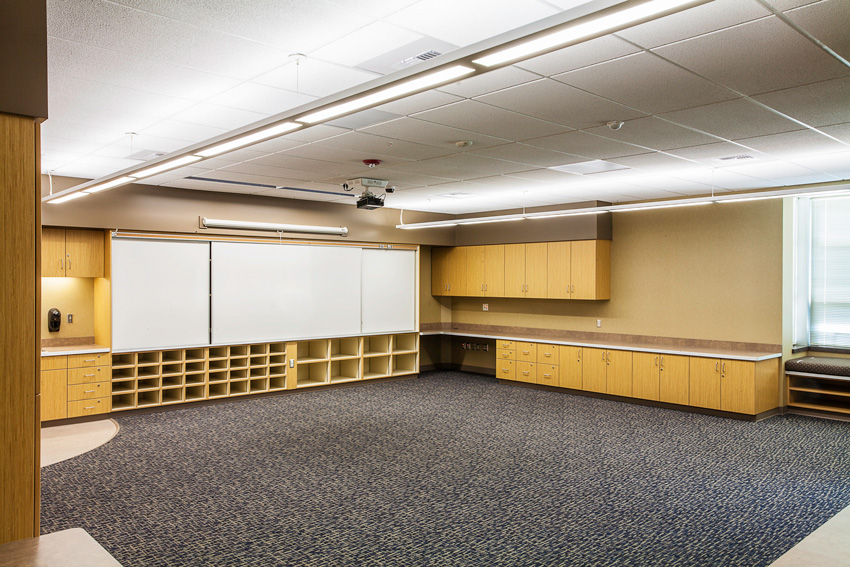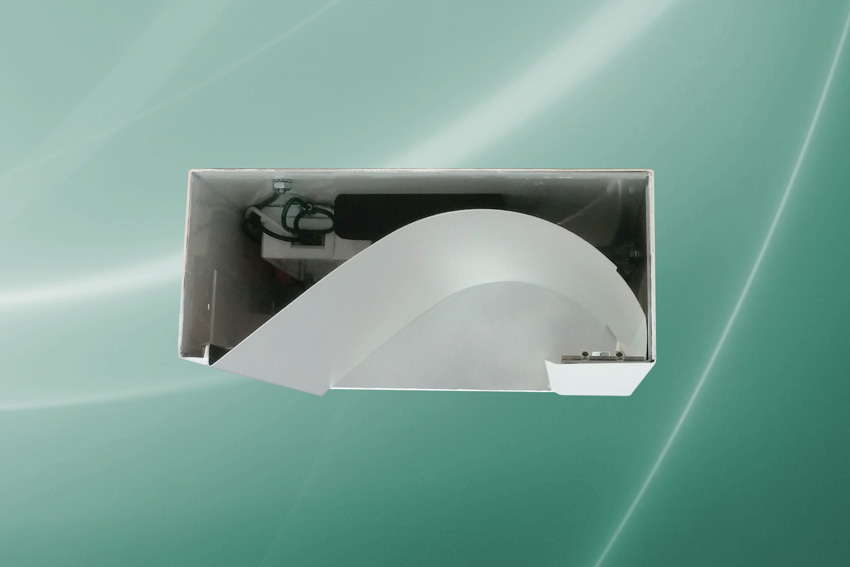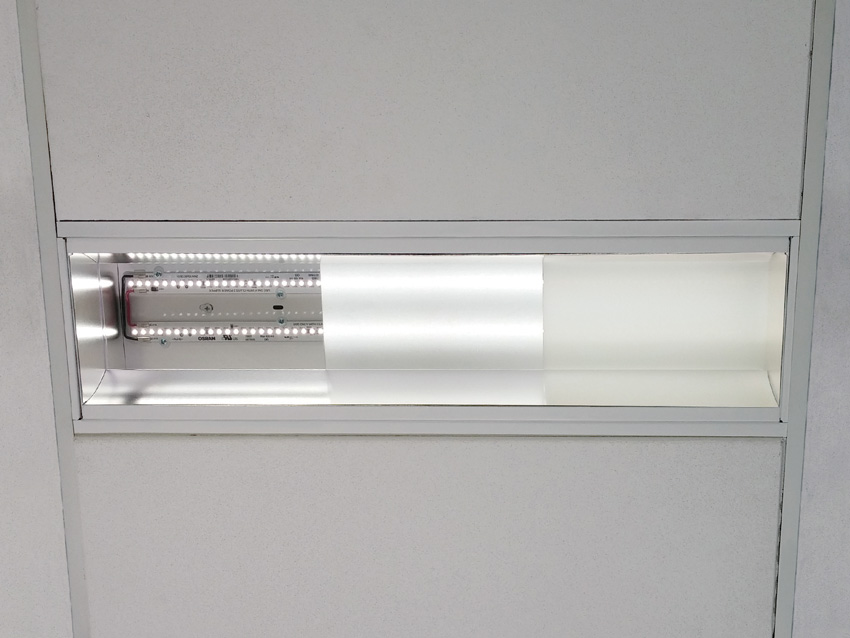The Characteristics of a High-Quality LED Luminaire
Provides More Light with Less Energy
Reducing the considerable energy consumption of a building’s lighting system has been the focus of much attention in the latest iterations of the national energy standard, the ANSI/ASHRAE/IES Standard 90.1: Energy Standard for Buildings Except Low-Rise Residential Buildings. So whether a project is attempting to meet current energy standards, exceed them to satisfy green building criteria, or simply save money by lowering the operating costs of the lighting system, specifying an efficient lighting system is a top-of-mind design objective in any project. Lighting fixtures that employ high-quality components are powerful tools in designing LED or fluorescent lighting systems that are able to achieve the highest levels of efficiency.

© Joe Nuess
Sunset View Elementary School combined energy-efficient direct/indirect fixtures for general illumination, and wall wash fixtures were chosen to illuminate the whiteboard.
Fixture Efficacy and Efficiency
There are two metrics used to determine the overall performance of a light fixture. Luminaire efficacy describes the amount of usable light, measured in lumens (lm), that a light fixture emits per watt (W) of electricity it consumes. Luminaire efficiency refers to the percentage of the lumens produced by the light source that are emitted as usable lumens by the luminaire.
Incandescent, fluorescent, and HID luminaires have for years been photometrically tested by a process known as relative photometry, which determines the efficiency of a light fixture. Because of heat management issues, the only way to properly test an LED fixture is to test the complete assembly, this is absolute photometry, which results in identifying the usable lumens emitted by the luminaire and the watts needed to power the luminaire, providing the luminaire efficacy of the fixture. While this is the established standard for testing LED luminaires, one must be careful when looking at the published efficacy of an LED fixture to be sure that the efficacy listed is the efficacy of the complete fixture and not just the efficacy of the LED light source alone.
It is important to note that fixture efficiency, and fixture efficacy, although important, cannot be the only consideration when selecting the best product for an application. For example, bare lamps are the most efficient light sources available because 100 percent of the light emitted by the lamps is transmitted into the interior space, but they are rarely used in commercial applications, as they are unable to meet other important performance goals, such as appropriate light distribution and glare control.
The Light Source, the Lens, and the Reflector
It is the optical system, within a fixture, that directs the light emitted by the light source into the interior space, ultimately determining the efficiency of the fixture. The optical system is comprised of up to three components. They are: the light source, the lens, and the reflector. The light source emits the light. The lens, if part of a fixture, is the material that the light passes through as it enters the interior space. The reflector is the enclosure around the light source tasked with managing the light that does not pass directly from the light source into the space. The quality of these components and the design of the fixture can have a profound effect on the overall efficiency that the fixture is able to achieve. They also impact many of the other design goals of the LED fixture, such as effectively shielding the overly bright LED source from being directly visible to occupants in a space.
A High-Quality Reflector
The functionality of a high-quality reflector is two-fold. It reflects a substantial portion of the emitted light, instead of absorbing it, and then directs the reflected light out of the fixture in a controlled and expedient manner. This is important because a light ray loses energy and intensity with every reflection that occurs. If the reflector allows light to bounce around randomly inside the fixture, a significant amount of generated light intensity is wasted.

Image courtesy of ELP Lighting
The cutaway endplate reveals a high-reflectance, one-piece, tension-held aluminum reflector. This reflector provides an even asymmetric wash of light, free from striations that can occur from multi-piece reflectors that are mechanically secured.
There are many materials that are used as the reflector in a fixture. It can be as basic as a metal box painted white or simply bent and polished aluminum, which can provide a reflectance rate of around 70 percent. There is a highly reflective white paint that can yield a reflectance of over 80 percent. Many reflectors are made from aluminum that has been modified in some way. Some aluminum reflectors have a silver film applied to their surface, while others have been treated with a highly reflective mirror coating. These more advanced reflectors can achieve reflectance rates of up to 97 percent.
The surface of the reflector plays a critical role in how the light is managed within the fixture. A reflector with a microscopically smooth surface, like a mirror, creates a type of reflection known as specular reflection. Specular reflection reflects the light rays in one direction, creating a concentrated, controlled, and directed reflection. A reflector with a rough surface causes a diffuse reflection to occur in the fixture, scattering the rays of light haphazardly in different directions. The lighting industry has also created semi-specular reflectors that offer a slightly diffuse reflection. These offer improved control over the usual diffuse reflection, but enable fixtures to achieve a wider, more uniform distribution of light than is created by the concentrated specular reflections.
It should be noted that the surface of the reflector, whether smooth or rough, does not indicate the reflectance of the material, only the directionality that the reflected light will have. A poor reflector may absorb a large portion of the light emitted by the source and reflect what is left in a specular, semi-specular, or diffuse manner.
A Highly Transmittant Lens
The transmission rate of a lens refers to the amount of light that passes through the lens and into the interior, instead of being absorbed or reflected back into the fixture housing. Fixture lenses are available in a variety of materials, from a clear piece of prismatic acrylic or glass to a frosted or milk-white translucent cover. A clear, highly transmittant lens is capable of transferring 97 percent of the light that strikes it into the space. Frosted and milk-white lenses have much lower transmittance rates and higher absorption rates than their clearer counterparts. Frosted lenses can reduce fixture output by as much as 12 to 15 percent, dramatically affecting the overall efficiency of the fixture.

Image courtesy of ELP Lighting
This downlight illustrates the impact that a lens can have by showcasing three different lenses side by side: a clear lens (left), a frosted lens (center), and a milk-white lens (right).
The LED Fixture Performance Myth
The most important lesson to take from this section is that the performance of the fixture is based on more than the efficacy of the light source. It is a mistake to assume that any LED fixture will be a more efficient lighting choice than anything else available. While an LED has a greater efficacy than most light sources, poor management of the light by the fixture or the use of low-quality components will quickly erode the efficiency of even an LED fixture. On the other hand, linear fluorescent fixtures that boast an innovative design and employ quality components may rival or exceed the efficiency of a basic LED fixture.









